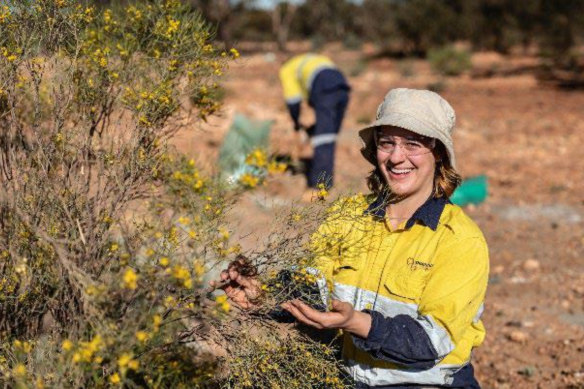- Sponsored
- Business
- Companies
- Bulls N' Bears
‘Big Dogs’ lift junior mining partners to greater heights
Brought to you by BULLS N’ BEARS
By Craig Nolan
After a few years of “easy money”, a big chunk of the small-cap mining sector has recently found the going tough as global financial pressures have seen widespread interest in the highly-speculative bottom-end of the market come to a screeching halt.
And that has required more business agility than ever, including strategic boardroom moves to try and attract established, big-spending partners to the share register. But more on that shortly.

Getting into bed with the mining industry’s big dogs is a proven share price booster for the industry’s juniors.
For a few years until mid-2022, a company only had to announce a sniff of something big – such as a “high-grade rock chip” result, or the acquisition of a promising rare earths or lithium project – and its share price would go bananas and take off on a run that would put a seasoned marathon runner to shame.
Market punters seemed to be more than eager to part with their hard-earned cash to subscribe for more stock through a share purchase plan, or to bid up the price of the company through a market frenzy. That made it easy for companies to raise funds at a high price from wealthier types or investors who could smell more easy money that could be made.
Then there was a noticeable shift in the usual proceedings.
Punters who had become accustomed to the huge intraday gains that were a regular occurrence, suddenly found profits hard to come by as various metals retreated in price.
Firstly, in 2022, the nickel and cobalt prices started to sink, all at a time when precious metals weren’t doing much business. Then early last year, the lithium bubble burst from its all-time price highs and rare earths followed suit.
It sent the hopes of many investors hunting for a quick profit down the good old “S” bend.
Unless there was a compelling story to tell – think Azure Minerals or Wildcat Resources – virtually every capital raise was being offered at a huge 30 to 40 per cent discount off the previous closing price. It seemed to be the only way the “little Aussie battlers” could generate sufficient interest to raise the desired funds.
But some companies were smart and sensing the potential difficulties they would face in raising required funds – at a hugely-discounted scrip price, no less, they decided to take a different approach of getting into a business bed with a “big dog”, a much bigger mining firm with deeper pockets and a more credible ability to raise funds.
Interest from a bigger company would see the red carpet rolled out, wisely it must be said, as the hopeful junior partner lobbied for an investment either in the shape of taking a sizeable stake in the firm or forming a joint venture (JV) at a prospective project.
A good example is Ardea Resources, a company sitting on possibly Australia’s biggest nickel resource of 854 million tonnes at 0.71 per cent nickel and 0.045 per cent cobalt for 6.1 million tonnes of contained nickel and 386,000 tonnes of cobalt.
In February 2022, when the sun was shining brightly for nickel developers and producers, Ardea received an unsolicited email from Japan’s $US10 billion (AU$15.26 billion) behemoth Sumitomo Metal Mining expressing interest in the company’s Kalgoorlie Nickel Project (KNP). As the nickel price was still flavour of the month and motoring along nicely, Ardea could have treated the approach with indifference.
Instead, management jumped at the opportunity to begin discussions with the mining giant to see what it could potentially offer. Talks progressed slowly at first, initially on a weekly basis before ramping up to almost daily discussions when Sumitomo’s genuine interest became clear.
About the same time, the Government-owned Export Finance Australia introduced Ardea to Mitsubishi Development, the wholly-owned mineral resources arm of the Japanese giant, Mitsubishi Corporation.
Ardea started separate discussions with the Japanese pair until it realised they were communicating with each other about the merits of the nickel project. It eventually led to all three companies sitting down and having joint discussions, with a further potential Japanese participant, Mitsui & Co, also being welcomed into the fold.
The discussions finally paid dividends when Ardea revealed on July 5 last year that a non-binding memorandum of understanding (MoU) had been signed with the Japanese consortium, with plans to formalise a scope of work to develop the Goongarrie Hub operation within the KNP through a JV arrangement. The deal was designed to lead to joint project funding, in addition to a final investment decision (FID) for the massive nickel operation.
The market clearly liked what it heard, sending the shares that previously closed at 44.5c to a high of 80c, on a volume of 2.81 million shares traded – well above the company’s daily average of less than 500,000. The price rallied again the following day, on even higher volume of about 3 million shares and again touched an intraday high of 80c.
When the dust had settled, the share price retreated to a low of 34c on January 23 this year. But the price started to slowly climb again before Ardea landed its big fish, revealing to the market on April 29 that a JV agreement between Sumitomo, Mitsubishi and Ardea had been formalised, with Mitsui electing to drop out.
The 50:50 JV between Ardea and the Japanese consortium revealed the latter will fund $98.5 million to develop a definitive feasibility study (DFS) for Goongarrie Hub. Once again, the market jumped, sending the shares to a high of 95c on the day as Ardea’s decision to link-up with the Japanese giants proved to be a fruitful one.
Another company benefitting from a tie-in with a much bigger player is Magmatic Resources after it revealed to the market on March 8 this year that iron ore giant Fortescue had executed an earn-in JV with the company for its Myall copper-gold-silver project near the New South Wales town of Narromine.
Fortescue agreed to spend up to $14 million during a six-year period to earn up to a 75 per cent interest in the project. A maiden mineral resource for Myall was defined last year from the project’s Corvette and Kingswood prospects, consisting of 110 million tonnes at a grade of 0.33 per cent copper equivalent.
But the big Andrew Forrest-led miner went even further by becoming a cornerstone investor in Magmatic, acquiring a 19.9 per cent stake to raise about $3.7 million for the mining junior, which it plans to use to advance its other projects including its Boda Southwest prospect that lies immediately adjacent to Alkane Resources’ massive 15.7 million-ounce gold equivalent Boda-Kaiser deposits that sit in central NSW.
The market gave an approving nod to the reveal, sending the shares that had closed at 4.5c on March 7 to a high of 8c on the day the JV was announced. The stock was boosted even higher on the next trading day to touch 10c, an 11-month high, while a peak of 13c was reached on April 3.
Volumes surged with 13.3 million units traded upon the JV disclosure and 8.5 million the following day, levels well above its 20-day average of about 300,000 in daily turnover.
On October 30 last year, Western Australian gold producer Ora Banda Mining notified the market that a transformational lithium JV farm-in agreement was executed with ASX-listed conglomerate Wesfarmers through its Chemicals, Energy & Fertilisers’ subsidiary Brenahan Exploration. Ora Banda disclosed it had sold 65 per cent of the company’s non-core mineral rights, excluding gold, at its Davyhurst ground package for a cool $26 million in cash, plus a 2 per cent royalty.

Ora Banda Mining got a share price kick when it revealed a $26 million investment from Westfarmers.
Brenahan and Ora Banda formed a 65:35 JV to advance exploration on the sizeable underexplored ground, with the former having the option to solely fund $15 million of exploration during the first three-year period to increase its JV stake to 80 per cent. Ora Banda management said it would be free-carried from any discovery through to the completion of a DFS, giving Brenahan the option to acquire its remaining JV interest on project ground that is covered within the DFS.
The market reacted positively to the news, pushing the price from its previous 13.5c close to a 16.5c high on a healthy volume of 12.9 million shares.
The company’s share price move after the reveal was a “slow-burn” initially, with occasional jumps in volume on select trading days giving it the impetus to move higher. In what appears to be an all-time record for traded volume of its shares, 52.46 million units then changed hands on November 10, lifting the price to 17.5c.
Further intermittent boosts to the volume saw the price eventually touch 25c on December 4, a near three-year high. The share price effectively moved sideways for a few months until positive news on both of the company’s Sand King and Riverina underground developments, with reports of several stellar drill intersections continuing the positive momentum.
After touching a low of 12c on December 15 last year, Novo Resources stunned the market just four days later when it confirmed that global lithium giant Sociedad Química y Minera de Chile’s wholly-owned subsidiary SQM Australia had agreed to pay $10 million for a 75 per cent interest in five of its promising lithium-nickel tenements in WA’s West Pilbara region, near the town of Roebourne.
The payment formed the Harding Battery Metals JV and provided an option for additional Novo tenements to be rolled into the agreement package within a year. All tenements within the JV are adjacent to the Andover lithium-nickel project formerly owned by Azure Minerals, which has since been acquired for $1.7 billion by SQM and Gina Rinehart’s Hancock Prospecting.
With a closing price of 15c on December 18, the share price bolted out of the starting gates the next morning, opening at 17.5c before racing to an intraday high of 24.5c.
Volume surged on the day to 2.7 million shares, well above its previous 10-day average of near 200,000 and followed through the next day with another solid 1.3 million turnover.
Under the JV terms, SQM will be the manager of the operation, while Novo retains 100 per cent of any gold, silver, copper, platinum-group-elements (PGE), lead and zinc and is free-carried until a decision to mine.
These are just a handful of the many examples of junior companies making an ultimately beneficial decision to join forces with a bigger, more powerful ally which can provide the capital backing required and the financial firepower to keep a project moving forward.
Is your ASX-listed company doing something interesting? Contact: mattbirney@bullsnbears.com.au